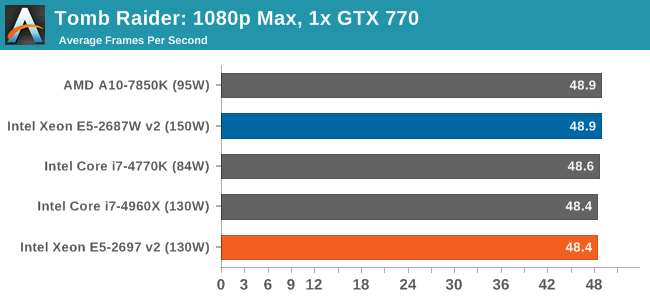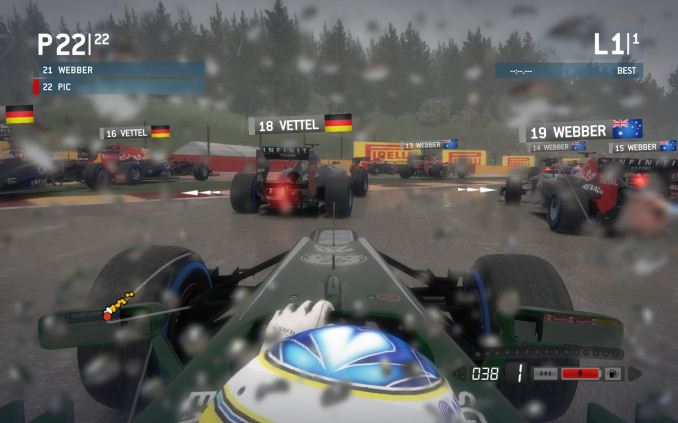Intel Xeon E5-2697 v2 and Xeon E5-2687W v2 Review: 12 and 8 Cores
by Ian Cutress on March 17, 2014 11:59 AM EST- Posted in
- CPUs
- Intel
- Xeon
- Enterprise
For our gaming benchmarks we brought in the MSI X79A-GD45 for some three-way GPU action, as the original GIGABYTE motherboard is limited beyond two GPUs. For the Xeons in our tests, the PCIe arrangement gave x16 in single GPU mode, x16/x16 in dual GPU mode and x16/x16/x8 in tri-GPU mode.
F1 2013
First up is F1 2013 by Codemasters. I am a big Formula 1 fan in my spare time, and nothing makes me happier than carving up the field in a Caterham, waving to the Red Bulls as I drive by (because I play on easy and take shortcuts). F1 2013 uses the EGO Engine, and like other Codemasters games ends up being very playable on old hardware quite easily. In order to beef up the benchmark a bit, we devised the following scenario for the benchmark mode: one lap of Spa-Francorchamps in the heavy wet, the benchmark follows Jenson Button in the McLaren who starts on the grid in 22nd place, with the field made up of 11 Williams cars, 5 Marussia and 5 Caterham in that order. This puts emphasis on the CPU to handle the AI in the wet, and allows for a good amount of overtaking during the automated benchmark. We test at 1920x1080 on Ultra graphical settings for a single GPU, as using multiple GPUs seems to have no scaling effect.

| F1 2013, 1080p Max | ||
| NVIDIA | AMD | |
| Average Frame Rates |
|
|
| Minimum Frame Rates |
|
|
While the higher frequency of the E5-2687W v2 puts it ahead of the 12-core Xeon, in each of our data points, except 3x HD7970, the Core i7-4960X gets the better frame rates.
Bioshock Infinite
Bioshock Infinite was Zero Punctuation’s Game of the Year for 2013, uses the Unreal Engine 3, and is designed to scale with both cores and graphical prowess. We test the benchmark using the Adrenaline benchmark tool and the Xtreme (1920x1080, Maximum) performance setting, noting down the average frame rates and the minimum frame rates.

| Bioshock Infinite, 1080p Max | ||
| NVIDIA | AMD | |
| Average Frame Rates |
|
|
| Minimum Frame Rates |
|
|
Again, the 8-core higher frequency Xeon is faster than the 12-core Xeon in most of our tests, however the i7-4960X beats them most of the time. For certain arrangements, such as 2x HD7970, the Xeons lose slightly to the i7-4770K, most likely due to CPU IPC. However as the difference is only a couple of frames per second out of 130, this should not make much difference.
Tomb Raider
The next benchmark in our test is Tomb Raider. Tomb Raider is an AMD optimized game, lauded for its use of TressFX creating dynamic hair to increase the immersion in game. Tomb Raider uses a modified version of the Crystal Engine, and enjoys raw horsepower. We test the benchmark using the Adrenaline benchmark tool and the Xtreme (1920x1080, Maximum) performance setting, noting down the average frame rates and the minimum frame rates.

| Tomb Raider, 1080p Max | ||
| NVIDIA | AMD | |
| Average Frame Rates |
|
|
| Minimum Frame Rates |
|
|
In all the Tomb Raider tests, all the CPUs perform similarly, making Tomb Raider a seemingly agnostic test to CPU power.













71 Comments
View All Comments
lever_age - Monday, March 17, 2014 - link
Ian, the Xeon E3-1220v3 and E3-1225v3 do not have hyperthreading. They're incorrectly listed in the table as 4c/8t. At those prices, if they did have 8t, more people would be buying them! Also, I think that "c3" by the E3-1230 is a typo.Ian Cutress - Monday, March 17, 2014 - link
Correct, I missed that going through the data.psyq321 - Monday, March 17, 2014 - link
"If the E5-2697 v2 was put in this position, we would have 12 cores at 3.5 GHz, ready to blast through the workload."I do not think this is possible. I have tried to force all cores to turbo mode with ThrottleStop on the 2697v2 Xeon (ThrottleStop bypasses the BIOS/UEFI and codes the limits directly using MSR registers), but the CPU will just refuse to grant this.
I suppose the desktop CPUs simply have this option unlocked, while 2S/4S Xeons have much stricter operating point limits.
The best I can do with 2697 v2 is to set the BCLK to 105 MHz with Z9PE-D8 WS and get 3.15 GHz maximum all-core turbo. This is as much overclock as the system can take.
Ian Cutress - Monday, March 17, 2014 - link
I've managed to get 110 BCLK on both processors relatively stable (112 BCLK needs a push), but this boosts up from the lower multiplier rather than the high one, and there is still a deficit on the high end. Enthusiasts will always want more, and I'd love the chance to run all the cores at the top turbo mode. Given how this is on the consumer line, it makes me wonder why Intel doesn't allow it here. The downside on the consumer line of allowing this behaviour is every so often there is a motherboard that fails to implement any Turbo Core, which has happened in my testing already.psyq321 - Monday, March 17, 2014 - link
I suppose some Intel marketing people just wanted to stop a possibility of lower-end Xeon cannibalizing higher-end Xeons by cheap overclocking. There are markets even in server business that are OK with overclocking (low latency trading, for example).It is interesting that you got it to 110 MHz BCLK. Did you use a server/workstation board or a HEDT (X79) board?
Ian Cutress - Monday, March 17, 2014 - link
This was in the MSI X79A-GD45 Plus, an X79 board. There are some server market areas that do sell pre-overclocked systems in this way, while still using Xeons, if I remember correctly.psyq321 - Monday, March 17, 2014 - link
I think HEDT boards are better when it comes to overclocking, probably due to higher component tolerances.Z9PE-D8 WS is not that good, but then again, it is a 2S board and apart from some Supermicro products (the "hyperspeed" series), the only 2S board that allows at least some overclocking of DDR3 and CPU.
Slomo4shO - Monday, March 17, 2014 - link
I am perplexed by the gaming benchmarks... Any particular reason why the 4770K and A10-7850K don't show up on all of the single and double GPU benchmarks? Especially considering that you have some tri-fire benches of the a10-7850K...Ian Cutress - Monday, March 17, 2014 - link
The AMD does not allow dual NVIDIA cards because the platform does not allow SLI. I need to re-run the 4770K in a PLX8747 enabled motherboard to get 3x SLI results across the board (you cannot get 3x SLI without a PLX chip), and I have not had a chance to run either CPU on my BF4 benchmark which has just been finalised for this review. The A10-7850K and i7-4770K numbers were taken from the Kaveri review and some internal testing - now my 2014 benchmarks are finalised I can run it on more platforms as the year goes on.et20 - Monday, March 17, 2014 - link
Why aren't Xeon E3s the recommended CPUs for enthusiast desktops?They make more sense than the Core i5 and i7 which come with integrated graphics that never gets used.